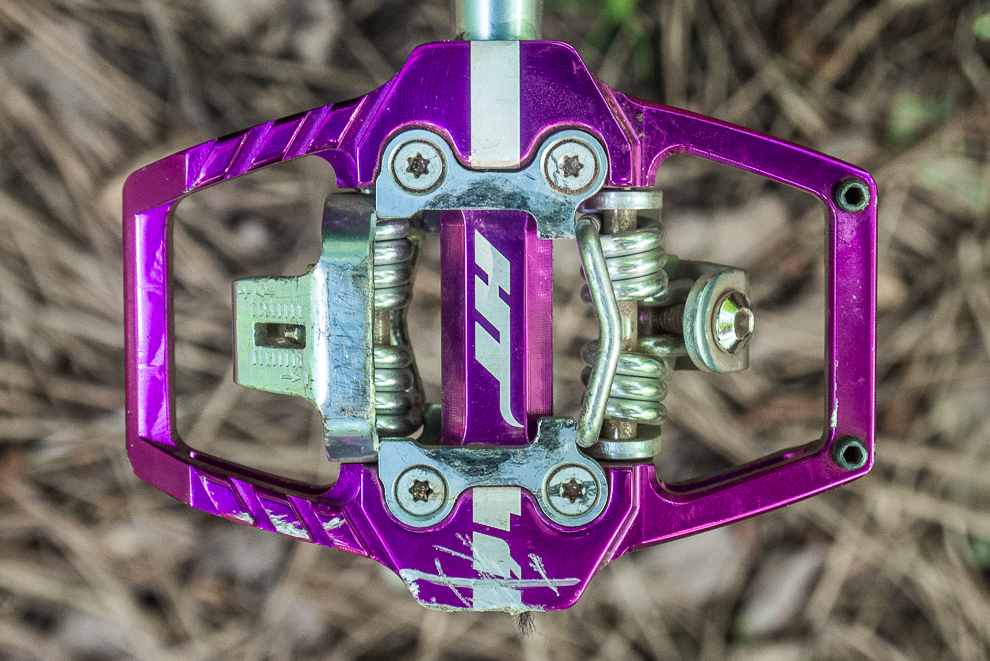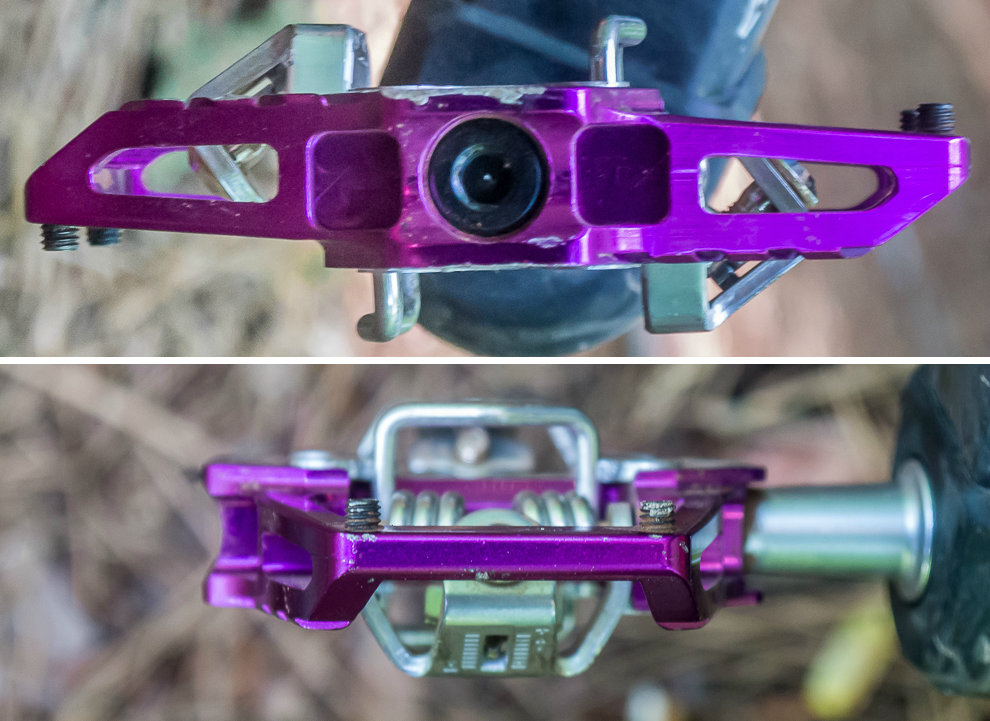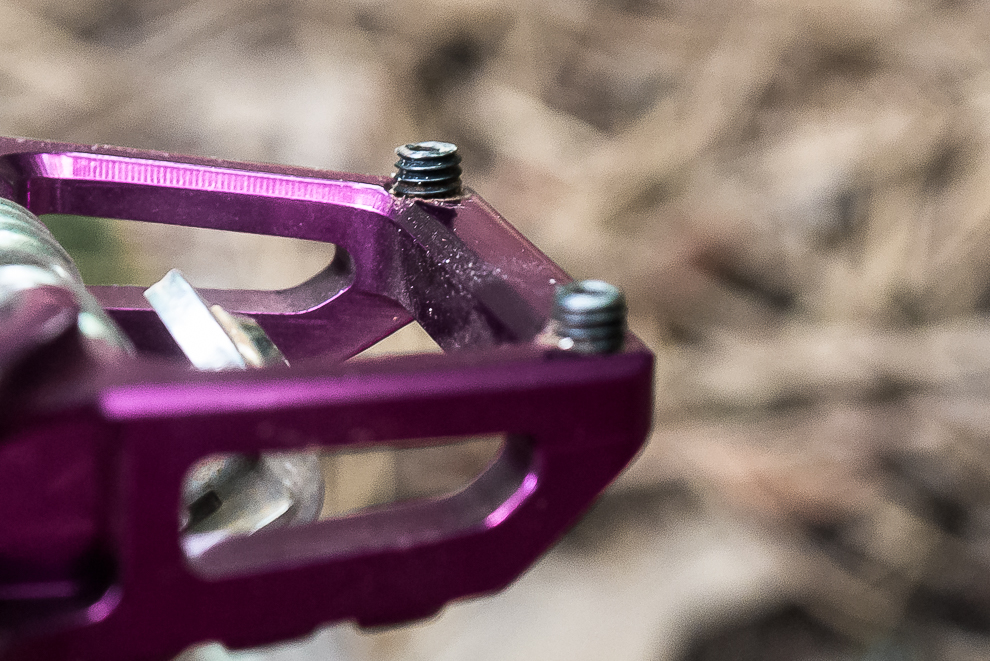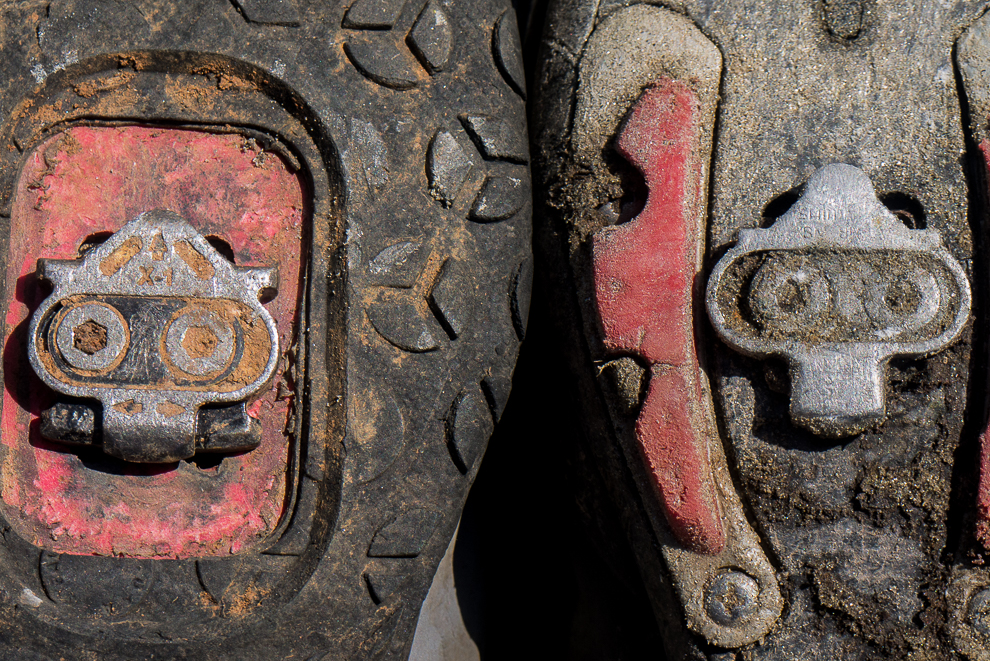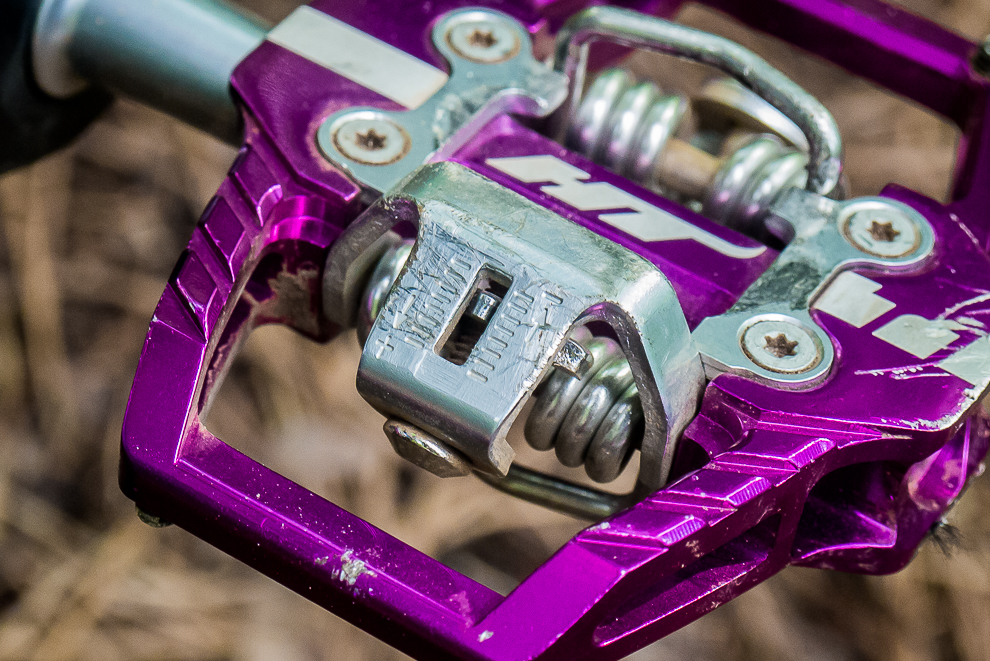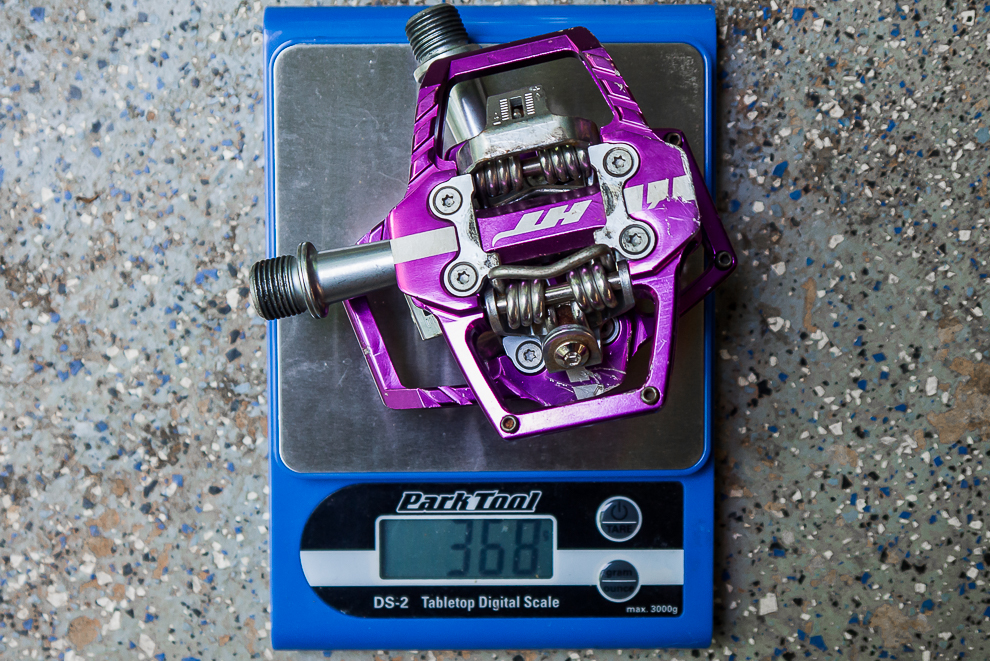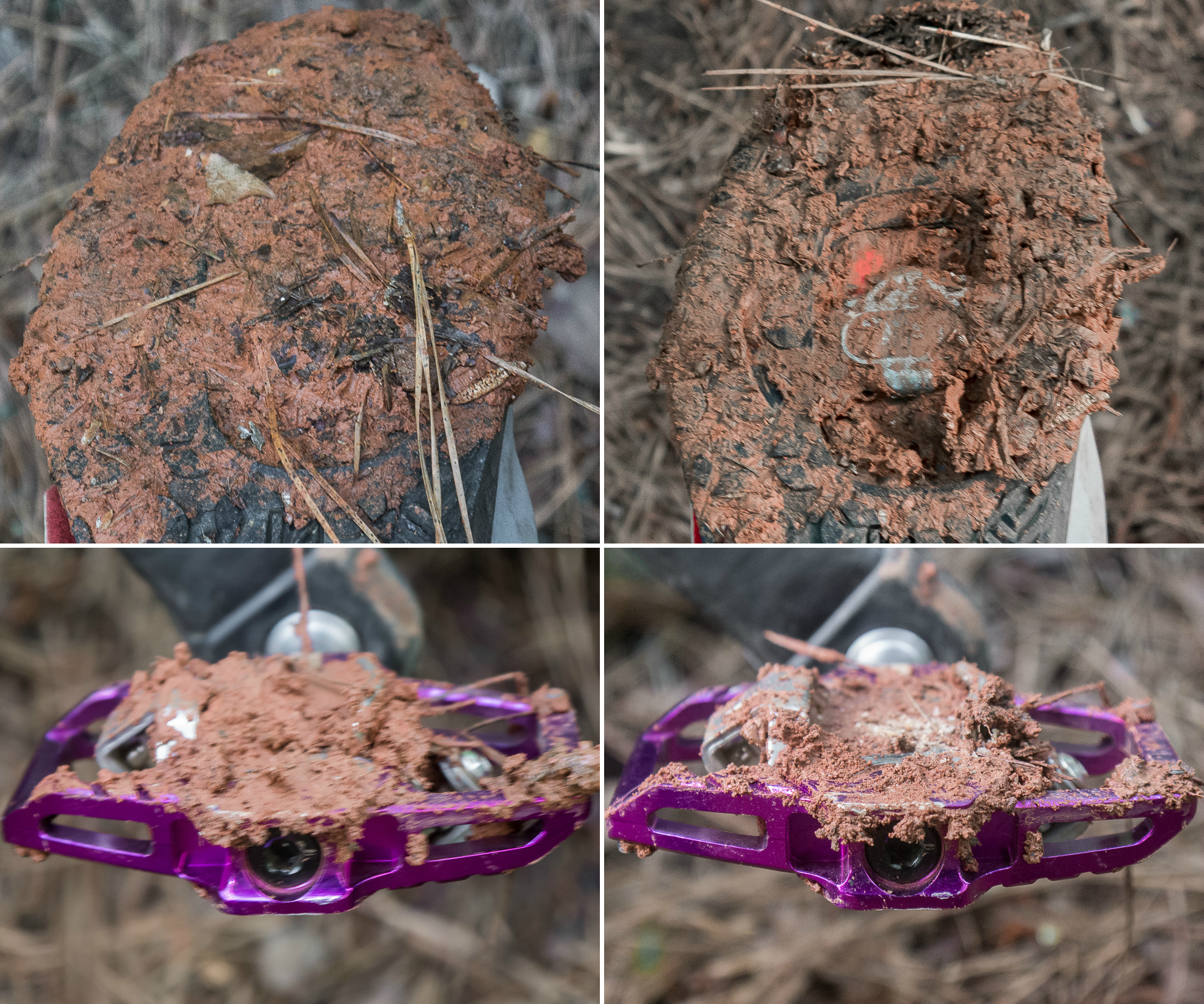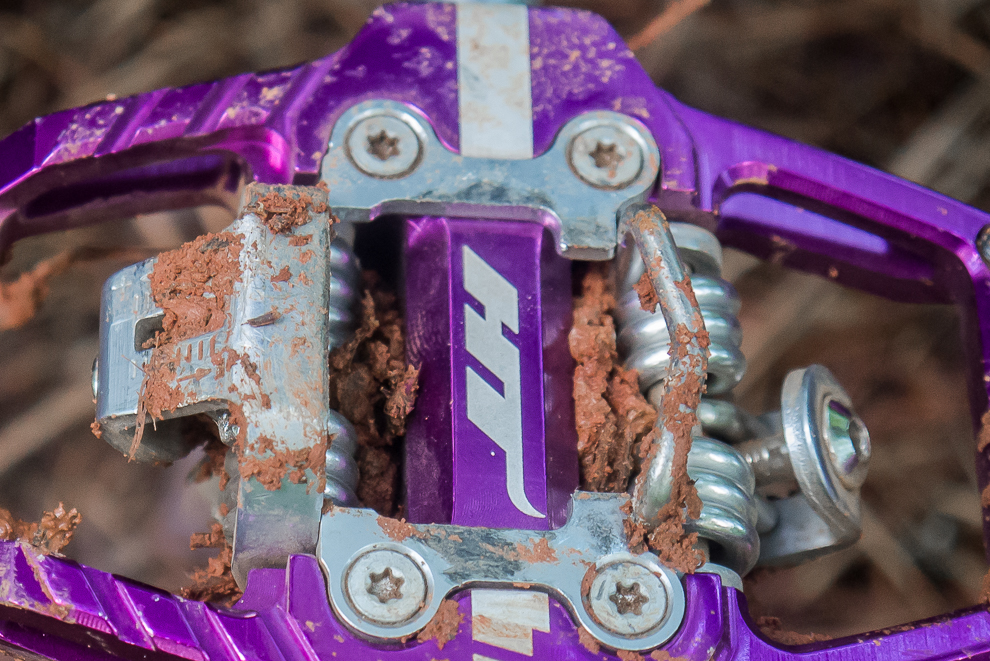We got our hands on an absolutely dazzling set of HT Components’ T1 Enduro/Race pedals (I got to pick the color out of the 11 they offer), to see what all of the buzz was about. Not to raise my expectations, but when World Champions like Jared Graves, Jerome Clementz, Aaron Gwin and Brian Lopes are clipping into HT Components’ pedals, there has to be a reason (besides money). Right?
After literally slamming and stuffing them with everything I had, including some thick Georgia red clay, I know why we’re seeing this small brand making strides under some of the most legendary riders… and there is more than one reason. But, they did have a couple of quirks. So, pro endorsements and overall positive performance aside, are they good enough to break my 25+ year dedication to Shimano’s SPDs?
I’ve ridden clipless on mountain bikes before the clipless mountain pedal existed. I had the bright idea to follow my then shop manager & mentor and put Look road pedals on my mountain bike. Well, due to not having nearly as refined BMX chops as him, I had to “dab” and dismount more often, letting various types of debris get between the pedal and cleat. I took them off after the 2nd (death) ride. When Shimano introduced the first SPD pedals, to say I was excited was an understatement. My coveted first generation 737’s are still somewhere in a parts bin in my garage and I have always said that SPD pedals are one of the best innovations on mountain bikes just above suspension & e-bikes *ducks and runs*.
I’ve tried about every SPD compatible pedal out there but always came back to Shimano’s adjustable, reliable and bullet-proof pedals. When Shimano came out with the “Trail” version of their XTR pedal, I was immediately drawn to the extra platform since it better suited my riding style. Though there is an improved platform that compliments some of the less stiff non-XC shoes on the market, I didn’t feel the platform made things more “secure” feeling. A little more stable, yes… but with more aggressive bikes & trails evolving, it isn’t just about clipping in to be more efficient. You need that “sure footing” and don’t want to experience an accidental unclipping while using aggressive body english to correct a line or add a little whip to your air. Even cranked all the way down, my XTR Trail pedals never felt that secure…until they needed lube and became difficult to clip out of.
Though similar exactly the same size and platform as the XT & XTR Trail pedals, the HT T1 pedals have a couple of stand out features that I was eager to try but unsure I would like. I’ve learned that just adding stuff doesn’t necessarily make it better. Sometimes it’s just marketing hype.
The first thing I noticed was that the T1’s have pins up front. This is where I was a little worried. As much as I love pins stabbing into my Stealth soles when running flats, if there is one thing I am more afraid of than accidentally unclipping, it is NOT being able to unclip when I need to. I imagined the Stealth sole on my FiveTens would grab those little babies like my dog’s teeth in bacon when trying to twist my foot out. Well the truth is, that isn’t the case at all because I can almost fit my pinky finger in between the pins and the sole of my shoe when clipped in. So I’m scratching my head wondering “what’s the point”? The sole of my shoes are pretty stiff, but not “carbon XC shoe” stiff so to allow good feedback. Even downhillers need a stiff enough platform so not to injure their feet, which left me wondering if these pins are more show than go. I took a closer look and saw that my shoes had two distinct wear areas exactly where the pins “would” contact the sole while clipped in. With enough force… or body weight during impacts, the sole was actually contacting the pins, but only at those extreme moments.
A situation worth mentioning is loading the bike when going into a left or right kicker. Though I can’t rightfully say the pins kept my feet in place like when running flats, because of other traits, (more on that in a second), knowing they’re there adds a little extra insurance in the back of my mind letting me flick things around without doing an unintentional one-footer (this has happened on my XTRs). So my fear of the pins keeping me locked in was a non-issue, and it seems that they are only there for when it really matters. Your choice in shoes may vary, and the pedals do come with shims in case your soles are a little on the thick side. Even though I’m not completely convinced the pins are necessary, I decided that even if the 8 (total) pins added 100 grams to the pedals, I’d leave them there.
The HT’s cleat (left) differs quite a bit from that of Shimano’s (right). The more robust corners of the 4° X1 cleat seem to offer a more secure hold when clipped in rather than have that “floaty” feel like Shimano’s. In addition to the pins, this was just another little piece of the pie. Clipping in was as good as your average high quality pedal, but once in, there is a sweet spot you are kind of cradled into. There is still float, but it isn’t that overly loose “tap shoes on a marble floor” kinda float, (just go with it). The 4° float with a 13° exit allowed for a quick enough release when trying to get out at the last second.
With more aggressive bikes and trails evolving, I found myself having to crank down the spring tension on my XTR’s about as far as they would go to better keep my feet in the pedals. When I installed the HT T1 pedals and cleats, I clipped in with little effort and immediately unclipped to see how they held. My foot came out way too easily. I noticed they were set at the lowest tension, so being the pedal expert I am I tensioned them on the edge of past halfway. Clipping in was a little more difficult, but clipping out… well, they didn’t want to let go.
As you can see in the picture above, the tension is set a just under halfway and that is just slightly tighter than my XTRs cranked all the way down. So the extra tension in addition to the cleat design and (maybe) pins created a really secure interface without being too locked in. Also, a nod to the designers for using a more multi-tool common 3mm hex bolt to adjust tension rather than the frustrating 2.5mm on Shimano’s. The angle of the pedal’s body as well as the impact-marred plate containing the spring tension indicator did well deflecting rocks. And though functional, I thought the profile and design of the pedal is just downright sexy.
A couple of odd things about the T1’s… I discovered I could move the shoe a little side to side with my hand while clipped into the pedal, but never noticed this while riding. Where Shimano’s SPD system uses one fixed and one spring-loaded clip, HT’s are both spring-loaded so this may have had something to do with it. Another quirk was that my sole only contacted the outer platform. When cornering or mashing, that is the side of the foot that most of your weight is distributed to so while this also had me scratching my head, I couldn’t get over how secure my foot felt when clipped in.
HT Component’s T1 pedals came in at the exact claimed weight of 368 grams. My XTRs came in 5 grams heavier at 373 grams (Shimano claims 358 grams). For a pretty penny more, you can opt to save an additional 20 grams per pedal (328 grams), and get them with a titanium axle. Though I’ve only been on the HT T1s for only a couple of months, I am impressed how new they still feel. I warrantied my first set of XTR Trail pedals due to the spindles developing quite a bit of play, and after only a few months, the replacements are starting to exhibit a slight play as well. It’s worth noting, I’ve had numerous SPD pedals, including the “impossible to clip into” Dura Ace SPD road pedals from the 90’s (that probably have well over 30,000 miles on them alone), and never have any of them developed any play other than my XTR Trails.
Due to some recent rain and trail work done on our local jump run, there was a nice fresh pile of Georgia red clay just begging to clog some pedals. In a spackle like fashion I piled both the cleat and pedal with a healthy amount of mud. The pics above show the before and after of the shoe and pedal meeting. Though I did have a little trouble finding the point where the cleat catches the pedal (duh), once discovered, it took just a little extra effort, and I was in! The first release was a little tighter as well, but from the 2nd clipping in & out on, it was as if nothing was there.
The mud showed itself the door through and seemed to let the pedals perform on par even as trail conditions worsened. Even the people that paused their ride to witness my mad science seemed impressed… though the awkward lack of eye contact and concern that I may have hit my head was a bit odd.
So back to why I think (just a hunch), some of the world’s best riders may be stepping up -er, onto- HT’s new clipless offerings. While I will admit entering & exiting Shimano’s trail variant feels more refined, once in and things start getting sketch, I felt much more glued to the T1s. Once I got the tension set to where I liked it and they were lubed, (when they dry up, they are much harder to get out of), I never once felt I would accidentally come out of them. On the flip side, though it took a little more effort, popping out of the pedals at the last second to plant a foot wasn’t a problem.
Overall, the HT Components T1 pedals performed much better than I had expected. I must note that just like anything without set standards, the shoes that are designed for this pedal vary A LOT in design, so a little research might be in order to make sure you get the most out of any shoe/pedal combination. Regardless, going on feel and performance I was really happy with them. Even better, the price tag puts them in your hands for only $135 which is less than both the XTR & XT Trail pedals. Although I’m not going to toss any of my Shimano pedals in the garbage anytime soon, the T1’s are now my preferred choice for aggressive trail riding. I still love my Shimano XC SPD pedals on my cross-country and CX bikes, (though I’ve yet to ride HT’s M1 XC pedal) as the refined ease to get in and out of them are something I’ve grown to know and enjoy like a family member.
Based in Taiwan, Hsing Ta Industrial has been around for over 60 years making bike components. In 2005 they created HT Components to focus on the high-end pedal market. HT distributes their products through bikefettish.com here in the U.S.
